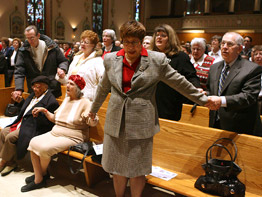Sue Barnabae nearly skipped Saturday evening Mass at St. Peter the Apostle, Jan. 26, because she thought the last regular Mass at her longtime west Baltimore parish would be too sad.
However, family members convinced the Catonsville resident to join the hundreds of faithful who packed the 166-year-old church at a Mass that has in recent years attracted fewer than 50.
“I knew I had to be here for this Mass,” said Nancy Eisenhardt, 60, of Glen Burnie, a parishioner of St. Philip Neri, Linthicum Heights. “I grew up in this neighborhood and went to school here. My children were christened here. I hate to see it close. I haven’t been a parishioner here in a long time, but I do come back from time to time.”
Beginning Feb. 2, regular services will cease at St. Peter the Apostle, St. Martin and St. Jerome, and parishioners are being asked to attend Mass at the new Transfiguration Catholic Community church building (formerly St. Jerome), located at the corner of Scott and West Hamburg streets.
While the three parishes have been known collectively as Transfiguration Catholic Community since 2004, Mass continued to be celebrated at the individual structures and the congregations remained separate, said Father Carter. Because fewer than 400 families were affiliated with the parish, Father Carter, officials from the Archdiocese of Baltimore and parishioners agreed last year it had become too costly to operate all three churches.
From the pulpit, Bishop Denis J. Madden, urban vicar, told the faithful he understood how difficult it was to leave their place of worship for a new church, but applauded their courage to merge congregations.
It took a great deal of faith for the disciples to follow Jesus from Nazareth to Galilee, Bishop Madden said, just as the move to the new Transfiguration Catholic Community will require a tremendous amount of devotion from parishioners.
Tears streamed down the faces of some of those gathered as Bishop Madden continued his homily.
“When it’s time to move on, it’s not an easy thing to do,” he said. “We have had wonderful works, blessings and grace in this parish. Gather that feeling of pride and set out on another journey of faith.”
Built in 1877, the Transfiguration Catholic Community building is the newest of the three churches. Father Carter said he plans to move familiar objects from St. Martin and St. Peter into the church and to complete interior renovations by the fall.
Father Michael Roach, pastor of St. Bartholomew, Manchester, and former pastor of St. Peter from 1980-1994, said he still feels a strong connection to the west Baltimore church, which was built in 1842.
Though the building received its patronage from the original St. Peter Pro-Cathedral, it was not built on the site of the old chapel, he said.
“The old St. Peter Pro-Cathedral was on Mulberry Street, where the old Cathedral School was located,” Father Roach said. “When the archdiocese was going to tear the old St. Peter’s Pro-Cathedral down, they transferred the altar relics and the pulpit to the new St. Peter the Apostle.”
St. Peter the Apostle holds the distinction of having seven bishops linked to it – through baptism, serving as a priest or living on site, he said.
“Bishop Thomas Becker of the Diocese of Savannah (Ga.) hid out there during the Civil War,” said Father Roach, noting its extensive history. “At one time it was the only Catholic church between the basilica and St. Paul, Ellicott City.”
Because baptisms, weddings, funerals and other special Masses will continue to be celebrated in the St. Martin and St. Peter the Apostle buildings after the congregations merge into one church, no special ceremony is needed to “de-sacrament” the structures, Father Carter said.
While there are currently no plans to sell the other buildings, they do hope to find efficient uses for them within the Transfiguration parish, Bish¬op Madden said.
A new sign reading “Transfiguration Catholic Community” will be placed on the St. Jerome building before all three congregations begin to worship there Feb. 2, he said.
A special procession will be held Feb. 2 at 10 a.m., beginning at St. Martin, progressing to the altar, and then to the altars of St. Peter the Apostle and the new Transfiguration Catholic Community, Father Carter said.
“It will be a way for us to unify our parish,” he said. “That spirit moves with us to Transfiguration parish.”
Ms. Barnabae hasn’t decided yet if she will worship regularly at the new Transfiguration Catholic Community, or if she will join a parish closer to her Catonsville home.
“I was married in this church in 1958, my children were baptized here and I’ve been a parishioner for more than 50 years,” she said. “I can’t make that kind of decision right now. I’ll just have to wait and see.”


